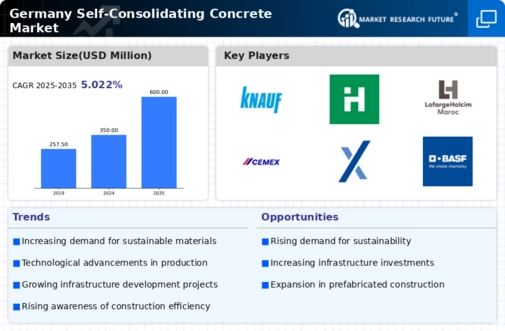Government Initiatives and Regulations
Government policies in Germany are increasingly favoring the use of innovative construction materials, including self consolidating-concrete. Regulatory frameworks are being established to promote sustainable building practices, which often include the use of advanced concrete solutions. In 2025, it is anticipated that government incentives will lead to a 15% increase in the adoption of self consolidating-concrete in public infrastructure projects. The self consolidating-concrete market stands to benefit significantly from these initiatives, as they align with broader goals of enhancing energy efficiency and reducing carbon footprints in construction.
Rising Demand for High-Performance Materials
The self consolidating-concrete market in Germany is experiencing a notable increase in demand for high-performance materials. This trend is driven by the construction industry's need for durable and efficient solutions that can withstand various environmental conditions. As urban areas expand, the requirement for robust infrastructure becomes paramount. In 2025, the market is projected to grow at a CAGR of approximately 8%, reflecting the construction sector's shift towards materials that enhance structural integrity and longevity. The self consolidating-concrete market is well-positioned to meet these demands, offering products that not only improve performance but also reduce labor costs and construction time.
Increased Investment in Infrastructure Projects
Germany is witnessing a surge in infrastructure investments, which is positively impacting the self consolidating-concrete market. With the government allocating substantial funds for transportation, energy, and urban development projects, the demand for efficient and high-quality construction materials is on the rise. In 2025, infrastructure spending is projected to increase by 12%, creating a favorable environment for the self consolidating-concrete market. This influx of investment is likely to drive innovation and expand the application of self consolidating-concrete in various infrastructure projects, further solidifying its market presence.
Growing Focus on Aesthetic Appeal in Construction
In the German construction sector, there is a growing emphasis on aesthetic appeal alongside functionality. Self consolidating-concrete offers unique design possibilities, allowing architects and builders to create visually striking structures without compromising on strength. This trend is expected to drive a 10% increase in the use of self consolidating-concrete in decorative applications by 2025. The self consolidating-concrete market is thus positioned to cater to this demand, providing solutions that meet both aesthetic and structural requirements, thereby enhancing the overall value of construction projects.
Technological Integration in Construction Processes
The integration of advanced technologies in construction processes is reshaping the self consolidating-concrete market. Innovations such as 3D printing and automated mixing systems are enhancing the efficiency and quality of concrete production. In Germany, the adoption of these technologies is expected to increase by 20% by the end of 2025, leading to improved consistency and performance of self consolidating-concrete. The self consolidating-concrete market is likely to see a surge in demand as construction firms seek to leverage these advancements to optimize their operations and reduce waste.



















Leave a Comment